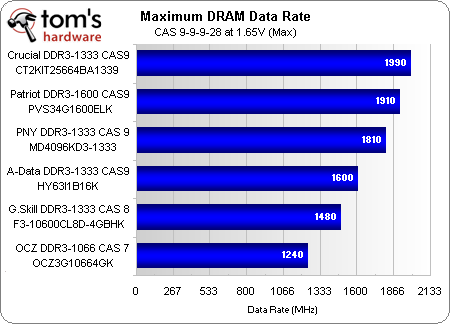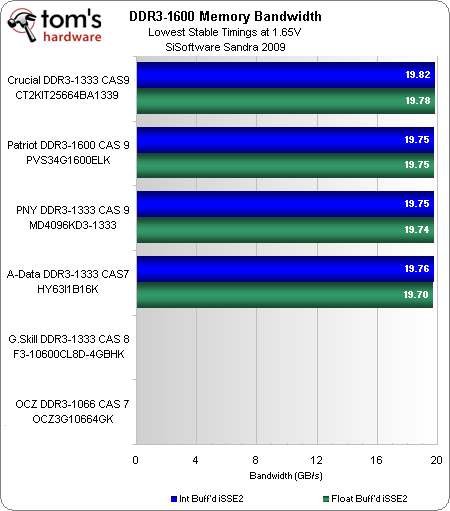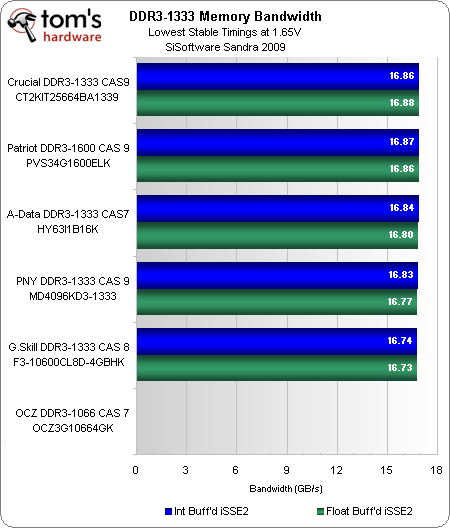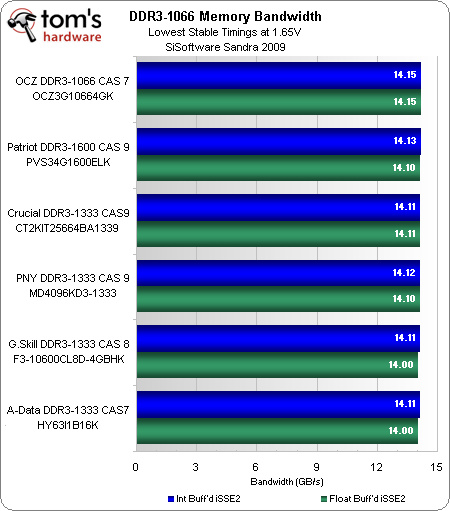Value DDR3 For Intel's P55: Six 4GB Kits Rounded Up
Test Results: Latency, Frequency, And Bandwidth
The official signal voltage limit of Intel’s integrated memory controller is 1.65V, which is well below the rated voltage of Patriot’s DDR3-1600. Yet we were able to reach Patriot’s full rated speed in spite of our lower voltage limit, and were even able to push the memory timings down significantly below its ratings.
| Best Timings at 1.65V | |||
|---|---|---|---|
| Row 0 - Cell 0 | DDR3-1600 | DDR3-1333 | DDR3-1066 |
| Patriot DDR3-1600 CAS 9 PVS34G1600ELK | 8-7-7-13 | 6-6-6-12 | 5-5-5-11 |
| Crucial DDR3-1333 CAS9 CT2KIT25664BA1339 | 8-7-7-18 | 6-6-6-15 | 5-5-5-12 |
| PNY DDR3-1333 CAS 9 MD4096KD3-1333 | 8-7-8-17 | 6-6-7-15 | 5-5-6-12 |
| A-Data DDR3-1333 CAS 7 HY63I1B16K | 8-8-7-13 | 6-7-6-12 | 5-6-5-10 |
| G.Skill DDR3-1333 CAS 8 F3-10600CL8D-4GBHK | N/A | 6-6-7-12 | 5-5-5-10 |
| OCZ DDR3-1066 CAS7OCZ3G10664GK | N/A | N/A | 5-5-4-11 |
Patriot takes the latency win at both DDR3-1600 and DDR3-1333, with Crucial behind only in tRAS. OCZ surprised us in two ways, first by reaching amazing CAS 5-5-4-11 latencies at its rated speed, and then by not being able to reach the next test speed at any latency or voltage settings.
Crucial edges out Patriot in overclocking, while similarities between the two in both overclocking and under-latency capability cause us to question whether Patriot uses the same Micron-brand ICs as its competitor. Unfortunately, we found it impossible to remove Patriot’s heat spreader without permanently damaging the modules themselves.
Crucial edges out Patriot with both kits set to their lowest stable DDR3-1600 settings. But differences this small are meaningless.
We see a repeat performance at DDR3-1333.
OCZ’s lower tRP latency puts it ahead at DDR3-1066.
Get Tom's Hardware's best news and in-depth reviews, straight to your inbox.
Current page: Test Results: Latency, Frequency, And Bandwidth
Prev Page Test Settings Next Page Super-Value Conclusion-
presidenteody should i wait for the price to be cut in half in 6 months? I want it now for L4d2!Reply -
dirtmountain Would running these same kits work any differently in an AM3 system with it's ability to handle higher voltages?Reply -
MAD4AMD Could you please provide information what memory chips are used in all RAMs. Thank you!Reply -
micky_lund looks good, especially for CAS9. spose it makes it better for OCing.Reply
pity it ain't available in Australia :S -
jrharbort I've always insisted that Crucial DDR3 kits are an excellent value, and recommended them to friends for their amazing stability, overclockability, and price.Reply
These kits totally deserved the Tom's award for best hardware of '09. -
mlcloud I've been buying OCZ for all my DDR2 needs (they were very cheap after rebates), but I think I know who to go to for DDR3 (and awesome power supplies)Reply





